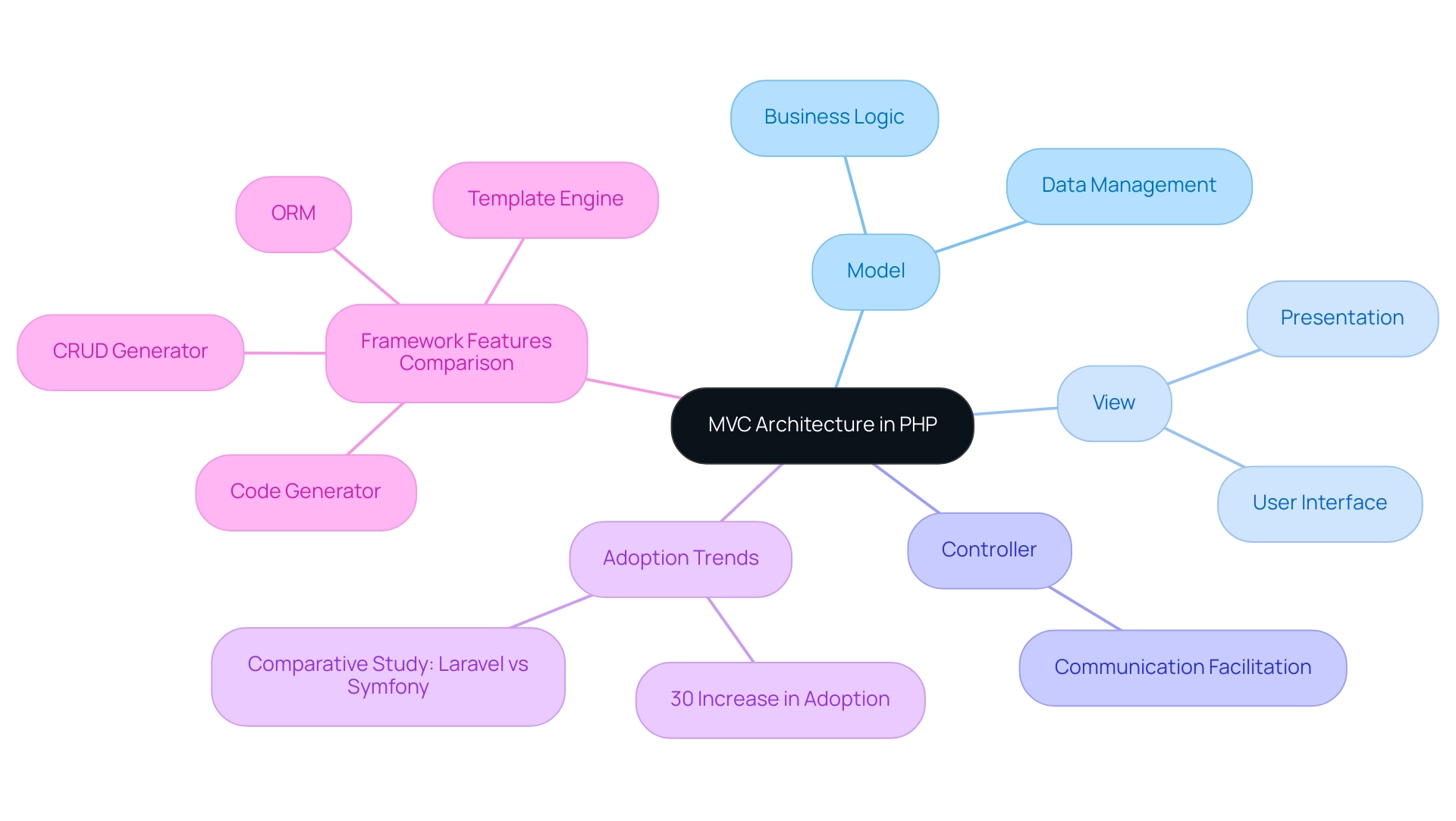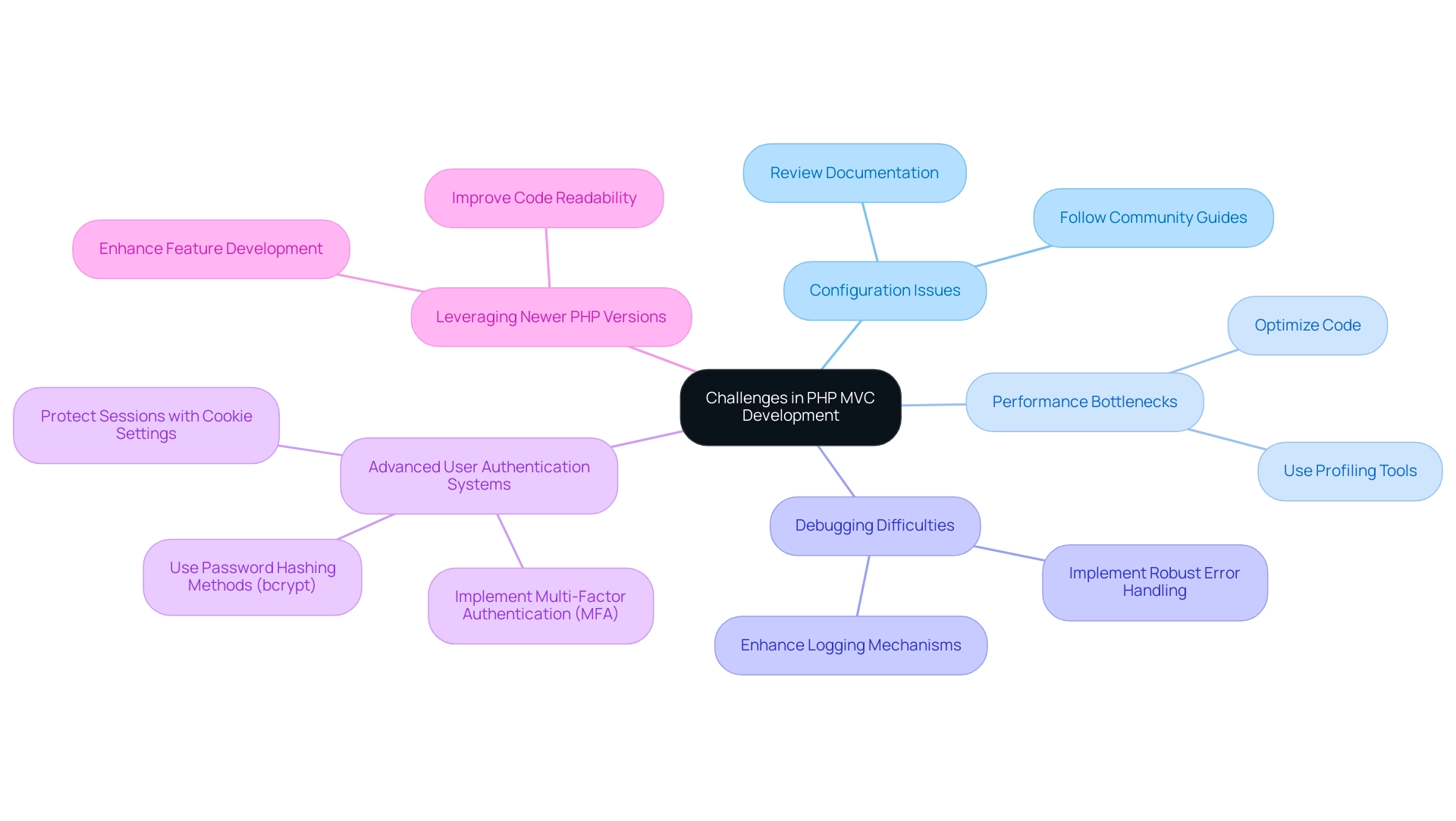Introduction
In the dynamic realm of web development, the Model-View-Controller (MVC) architecture has emerged as a cornerstone for creating efficient and scalable applications. By clearly delineating responsibilities among the Model, View, and Controller, developers can enhance not only the manageability of their code but also its adaptability to changing requirements. This structured approach allows for seamless updates and testing, paving the way for robust software solutions.
As the adoption of MVC principles continues to grow among PHP developers, understanding best practices and common challenges becomes essential for maximizing productivity. With the integration of advanced tools like Kodezi, developers can further streamline their workflows, ensuring that their applications are not only high-performing but also secure and maintainable.
As the landscape of PHP development evolves, staying ahead of emerging trends will empower teams to deliver innovative solutions that resonate with user needs and expectations.
Understanding the MVC Architecture in PHP
The Model-View-Controller (MVC) architecture is essential in web development, segmenting a system into three closely linked components:
- The Model, responsible for data management and business logic;
- The View, which oversees user interface and presentation;
- The Controller, facilitating communication between the Model and View.
This clear division enables creators to build software that is not only easier to manage but also more scalable and testable. For example, a well-designed MVC system permits modifications to the View without impacting the Model, thereby enhancing adaptability and significantly reducing maintenance efforts.
To maximize efficiency, it is crucial to start with a comprehensive understanding of how these components interact, ensuring effective implementation. Recent studies indicate that adopting frameworks PHP MVC architecture continues to gain traction among PHP practitioners, with its benefits being widely recognized in software development practices. For example, a comparative analysis of frameworks php mvc, specifically Laravel and Symfony, emphasizes the practical use of MVC principles, offering a model for programmers to assess their framework selections.
Additionally, statistics show that the adoption of frameworks PHP MVC among PHP programmers has increased by over 30% in recent years, reflecting its growing popularity. As Bhoj Raj Ghimire highlights, effective communication of architectural principles is essential for successful software creation, reinforcing the significance of MVC in contemporary systems.

Best Practices for Implementing PHP MVC Frameworks
To maximize the effectiveness of frameworks PHP MVC structures and enhance programming productivity, programmers should implement several best practices:
- Leverage the frameworks PHP MVC system's built-in functionalities to minimize redundant code, streamlining development processes.
- Uphold a consistent coding style to enhance readability and foster collaboration among team members.
- Regularly update the frameworks PHP MVC system to take advantage of new features and critical security patches, ensuring the software remains secure and efficient. As Aleksandar Savkovic emphasizes, "Join Joe Williams & Aleksandar Savkovic on 29th of March, 2021," highlighting the importance of staying connected with industry insights.
- Employ version control systems like Git to manage code changes effectively, facilitating smoother workflows and team coordination.
Furthermore, for complex projects, considering the choice between using a staging table or running queries directly can significantly impact data management efficiency. Integrating tools like Kodezi can further enhance these practices by providing automatic code correction, bug analysis, and productivity enhancements across multiple languages and IDEs. Kodezi CLI, specifically designed for teams, streamlines workflows by automatically healing codebases, which reduces the time spent on pull requests and enhances collaboration.
By adhering to these practices and utilizing Kodezi's capabilities, individuals can create applications that are not only robust and maintainable but also scalable, ultimately leading to superior performance and productivity. Additionally, the case study on security in PHP systems illustrates that both Laravel and Symfony provide top-notch security features, including robust user authentication and role management, reinforcing the necessity of incorporating security best practices within frameworks PHP MVC. Kodezi's unique focus on automatic debugging and its differentiation from tools like Copilot further solidify its value, making it an essential resource for programmers looking to optimize their coding practices.
The Importance of Modularity and Separation of Concerns
Modularity and separation of concerns stand as foundational principles in frameworks PHP MVC, crucial for maintaining high standards of code organization and clarity. By compartmentalizing functionality into distinct modules, developers in frameworks PHP MVC ensure that modifications in the Model do not disrupt the View, thereby simplifying updates and testing processes. This strategic separation enables simultaneous team efforts on various components without conflict, significantly speeding up timelines.
For instance, the CPU time required for jxt aim is just 2 seconds, highlighting the performance benefits associated with modular design. Furthermore, integrating automated code debugging solutions like Kodezi CLI enhances this modularity by autonomously identifying and fixing codebase issues before they reach production. Kodezi CLI provides detailed explanations and insights into what went wrong and how it was resolved, optimizing performance and ensuring compliance with the latest security standards and coding best practices.
The advocacy for modular design patterns, along with frameworks PHP MVC and adherence to principles like DRY (Don't Repeat Yourself), cultivates cleaner and more maintainable codebases, ultimately leading to enhanced collaboration among team members and amplifying overall efficiency. As James Howison notes, 'Writing – review & editing, Supervision,' the emphasis on these principles, coupled with AI-driven automated builds and testing, is crucial for effective software creation. Recent studies, including the case study titled 'Conclusion on Technical Interdependencies in OSS,' further highlight the importance of these technical interdependencies as they evolve, suggesting a shift in perspective that recognizes their significance in the software ecosystem.
Kodezi CLI not only addresses these interdependencies but also ensures adherence to security best practices, reinforcing its role as a vital tool for modern development teams.
Common Challenges in PHP MVC Development and How to Overcome Them
Navigating frameworks PHP MVC presents several challenges for programmers, including configuration issues, performance bottlenecks, and debugging difficulties. Given that a one-second delay in page load time can result in a 7% reduction in conversions, addressing these challenges is crucial for maintaining optimal system performance. To effectively tackle these issues, programmers should adopt the following strategies:
- Meticulously review documentation and community guides during the initial setup to prevent misconfigurations.
- Utilize profiling tools to pinpoint and resolve performance bottlenecks, ensuring that applications run smoothly.
- Implement robust error handling and logging mechanisms to facilitate easier debugging and enhance overall code quality.
Additionally, leveraging newer PHP versions can enhance feature development and code readability, making it easier to expand development teams and address these challenges effectively. A relevant case study is the implementation of advanced user authentication systems, where developers faced the challenge of creating robust security measures. By adopting multi-factor authentication (MFA), using password hashing methods like bcrypt, and protecting sessions with appropriate cookie settings, they successfully enhanced security without compromising performance.
By proactively approaching these challenges and maintaining a balance between delivering new functionality and refining existing code—as illustrated by the client's decision to continue cooperation after the initial month—developers can streamline their workflows and produce high-performing applications that meet user expectations. As Tom aptly noted,
Great post. I consider this constantly, particularly the aspect regarding where the business logic fits within current MVC structures.
This emphasizes the ongoing significance of these challenges in the evolving landscape of frameworks PHP MVC.

Future Trends in PHP MVC Frameworks
The evolution of PHP programming is marked by significant trends in frameworks PHP MVC, particularly with microservices architecture taking center stage. This approach enables developers to construct applications as a collection of small, independently deployable services, leading to remarkable enhancements in scalability and flexibility. Furthermore, the shift towards API-driven practices is gaining traction, facilitating seamless integration with diverse platforms and third-party services.
In the words of Inshal Ali, Content Marketer at Cloudways, 'With a background in computer science, the skill of content, and a whole lot of creativity, he helps businesses reach the sky and go beyond through content that speaks the language of their customers.' This highlights the importance of adapting to modern methodologies in PHP development, including frameworks PHP MVC. Additionally, PHP 8.0 introduced several groundbreaking features, as outlined in the case study titled 'PHP 8.0: The Foundation of Innovation,' which enhances performance and code clarity, making it a formidable choice for demanding applications.
Developers must also consider frameworks like PHPPixie, which is preferred by those seeking a lightweight framework with MongoDB support. By embracing these advancements, teams can deliver innovative solutions that not only meet but exceed user expectations, ultimately positioning themselves for success in a rapidly evolving environment.
Conclusion
Embracing the Model-View-Controller (MVC) architecture is essential for PHP developers seeking to create efficient, scalable applications. By understanding the distinct roles of the Model, View, and Controller, developers can streamline their workflows, enhance code manageability, and improve adaptability. The growing adoption of MVC principles among PHP developers, underscored by recent statistics, highlights its relevance in contemporary software development practices.
Implementing best practices such as:
- Leveraging built-in framework functionalities
- Maintaining a consistent coding style
- Utilizing version control systems
can significantly enhance productivity. Tools like Kodezi further empower developers by automating code corrections and facilitating smoother collaboration, leading to more robust and maintainable applications. As the article illustrates, prioritizing modularity and separation of concerns not only accelerates development timelines but also fosters an environment conducive to teamwork and innovation.
Addressing common challenges in PHP MVC development, such as performance bottlenecks and debugging difficulties, is crucial for maintaining optimal application performance. By proactively adopting strategies to overcome these hurdles, developers can ensure a seamless user experience while continuously refining their code.
Looking ahead, the evolution of PHP MVC frameworks is increasingly influenced by trends such as microservices architecture and API-driven development. By staying abreast of these advancements and integrating new features from PHP 8.0, development teams can deliver innovative solutions that resonate with user needs and expectations. Ultimately, leveraging the MVC architecture and the right tools empowers developers to meet the challenges of a rapidly changing digital landscape, positioning them for success and ensuring high-performing applications.
Frequently Asked Questions
What is the Model-View-Controller (MVC) architecture?
The MVC architecture is a framework in web development that divides a system into three interconnected components: the Model (data management and business logic), the View (user interface and presentation), and the Controller (communication between the Model and View).
What are the benefits of using MVC architecture in software development?
MVC architecture allows for easier management, scalability, and testability of software. It enables modifications to the View without affecting the Model, enhancing adaptability and reducing maintenance efforts.
How can programmers maximize efficiency when using PHP MVC frameworks?
Programmers can maximize efficiency by leveraging built-in functionalities to minimize redundant code, maintaining a consistent coding style, regularly updating the framework for new features and security patches, and using version control systems like Git for better code management.
What recent trends have been observed in the adoption of PHP MVC frameworks?
The adoption of PHP MVC frameworks among PHP programmers has increased by over 30% in recent years, indicating a growing recognition of its benefits in software development.
What tools can enhance programming productivity within PHP MVC frameworks?
Tools like Kodezi can enhance productivity by providing automatic code correction, bug analysis, and streamlining workflows. Kodezi CLI specifically helps teams by automatically healing codebases and reducing time spent on pull requests.
What security features do popular PHP frameworks like Laravel and Symfony offer?
Laravel and Symfony provide robust security features, including strong user authentication and role management, which are essential for maintaining secure applications.
Why is effective communication of architectural principles important in software creation?
Effective communication of architectural principles, such as those found in MVC, is crucial for successful software development, as it helps ensure that all team members understand the framework and can collaborate effectively.




